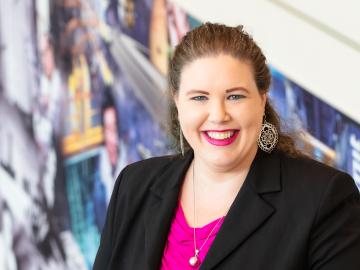
Filter News
Area of Research
- (-) Biology and Environment (56)
- (-) Materials (76)
- (-) National Security (26)
- Advanced Manufacturing (1)
- Biological Systems (1)
- Building Technologies (1)
- Clean Energy (63)
- Computational Engineering (1)
- Computer Science (2)
- Electricity and Smart Grid (1)
- Energy Sciences (1)
- Fuel Cycle Science and Technology (1)
- Fusion and Fission (19)
- Fusion Energy (3)
- Isotope Development and Production (1)
- Isotopes (15)
- Materials Characterization (2)
- Materials Under Extremes (1)
- Neutron Science (32)
- Nuclear Science and Technology (2)
- Supercomputing (73)
News Topics
- 3-D Printing/Advanced Manufacturing (7)
- Advanced Reactors (2)
- Artificial Intelligence (9)
- Big Data (6)
- Bioenergy (19)
- Biology (24)
- Biomedical (3)
- Biotechnology (5)
- Buildings (3)
- Chemical Sciences (17)
- Clean Water (3)
- Climate Change (18)
- Composites (3)
- Computer Science (11)
- Coronavirus (4)
- Critical Materials (4)
- Cybersecurity (7)
- Decarbonization (14)
- Energy Storage (6)
- Environment (35)
- Exascale Computing (2)
- Frontier (2)
- Fusion (3)
- Grid (4)
- High-Performance Computing (13)
- Hydropower (3)
- Irradiation (1)
- Isotopes (3)
- Machine Learning (9)
- Materials (42)
- Materials Science (9)
- Mathematics (2)
- Mercury (2)
- Microscopy (5)
- Molten Salt (1)
- Nanotechnology (4)
- National Security (15)
- Net Zero (2)
- Neutron Science (8)
- Nuclear Energy (7)
- Partnerships (10)
- Physics (10)
- Polymers (4)
- Quantum Computing (2)
- Quantum Science (1)
- Renewable Energy (2)
- Security (2)
- Simulation (13)
- Summit (2)
- Sustainable Energy (12)
- Transportation (4)
Media Contacts
The Autonomous Systems group at ORNL is in high demand as it incorporates remote sensing into projects needing a bird’s-eye perspective.

Anne Campbell has been selected as a topical editor for a special issue of the journal Frontiers in Nuclear Engineering, titled “Women in Nuclear Engineering Research.”

A DNA editing tool adapted by Oak Ridge National Laboratory scientists makes engineering microbes for everything from bioenergy production to plastics recycling easier and faster.

ORNL has entered a strategic research partnership with the United Kingdom Atomic Energy Authority, or UKAEA, to investigate how different types of materials behave under the influence of high-energy neutron sources. The $4 million project is part of UKAEA's roadmap program, which aims to produce electricity from fusion.

A team of researchers from ORNL has created a prototype system for detecting and geolocating damaged utility poles in the aftermath of natural disasters such as hurricanes.

Alice Perrin is passionate about scientific research, but also beans — as in legumes.

Ben Thomas recalled the moment he, as a co-op student at ORNL, fell in love with computer programming. “It was like magic.” Almost five decades later, he strives to bring the same feeling to students through education and experience in fields that could benefit nuclear nonproliferation.

For nearly six years, the Majorana Demonstrator quietly listened to the universe. Nearly a mile underground at the Sanford Underground Research Facility, or SURF, in Lead, South Dakota, the experiment collected data that could answer one of the most perplexing questions in physics: Why is the universe filled with something instead of nothing?

A scientific instrument at ORNL could help create a noninvasive cancer treatment derived from a common tropical plant.

Joanna Tannous has found the perfect organism to study to satisfy her deeply curious nature, her skills in biochemistry and genetics, and a drive to create solutions for a better world. The organism is a poorly understood life form that greatly influences its environment and is unique enough to deserve its own biological kingdom: fungi.


